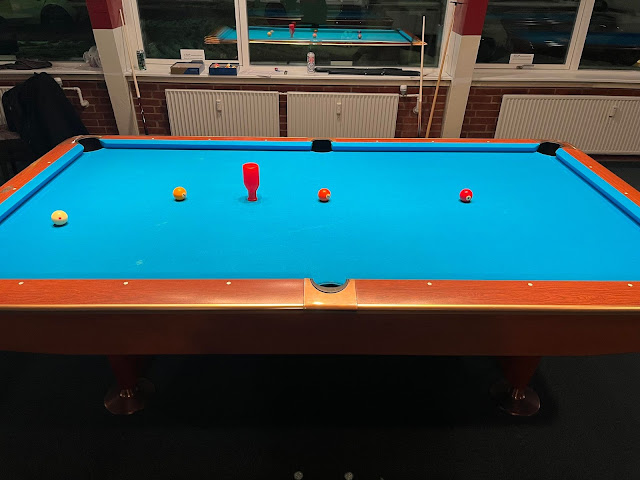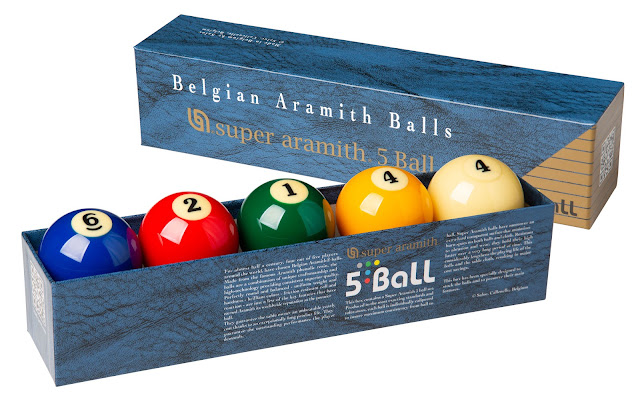One afternoon when I was browsing Wikipedia's cue sports section, I noticed a fair number of Snooker variants.
One in particular caught my eye: Sinuca Brasileira, Brazilian Snooker.
While this game, like Danish Pins, isn't terribly obscure in its home country, I can't seem to find many resources on it in English.
With that, this post will be dedicated to explain the rules for the game as simply as I can, the way I understand them.
If I get any details wrong, please let me know. I don't speak Brazilian Portuguese, so I had to rely on third party translations, Wikipedia, and YouTube for my sources.
Materials & Setup
To play this game, you need
- A Snooker table (any size)
- One of each colour Snooker ball
Sinuca only uses 1 red ball, as opposed to 15 used in the standard variant.
Note that the diagram is not to scale
To set up the game, set up all the balls the same way you would in regular Snooker, except place the red ball to the right of the pink ball, half-way between the pink ball and the cushion.
Here you can see the game set up on a real Snooker table. Image credit: noelsnooker.com.br
The Game
The object of the game is to score more points than your opponent by pocketing balls and slowly clearing them off the table.
The round ends once the last ball has been pocketed.
As with standard Snooker, the balls must be pocketed in sequence starting with the red, then the yellow, green, brown, blue, pink, then black.
The game differs from standard Snooker in exactly how you aim to accomplish this feat.
It does so via the introduction of two different types of shots, each with their own benefits.
The Break
To break, the starting player must place the cue-ball anywhere within the D behind the baulk-line at the head of the table, then shoot the red ball. The starting player has three tries at breaking. If they fail to do so, they foul and play goes to the other player.
Importantly, the starting player may never pocket the red ball nor Snooker it in the break.
To Snooker someone means to put the cue-ball in such a postition that the player who got Snookered doesn't have a direct shot at their only legal target.
Structure
The game is structured into two different types of shots:
- Free Shot
- Penalty Shot
On a player's turn, they may freely choose between either of these two types of shots, but they have to play it to completion. A player's turn continues as long as they don't make any mistakes.
The Free Shot is a "risk free" shot, where the active player simply tries to pocket the lowest valued ball (starting with the red ball and moving up sequentially).
Then, once the lowest-value ball is pocketed, the ball is scored, and the active player may nominate any (non-red) colour on the table to try and pocket.
If they're successful in pocketing the nominated ball, said ball is scored, then re-spotted, and they then go back to choosing between the Free and Penalty shots.
If either the Free Shot or the following nominated bonus shot is missed, the turn simply passes to the other player.
For Snooker players, this is like how you can nominate any non-red colour to pocket between each red, except because there's only one red in Sinuca, you can nominate any off-colour between every on-colour "free" shot. This essentially means a maximum break would be red, black, yellow, black, green, black, etc. (ignoring the option of penalty shots).
The Penalty Shot is riskier, as missing it is considered a foul. To perform a Penalty Shot, the active player then nominates any ball on the table as well as the pocket it has to enter. If successfully pocketed, the pocketed ball is re-spotted, and the next shot must be a Free Shot (with the accompanying nominated ball afterwards). If the player fails to pocket the ball, or fails to pocket in the nominated pocket, the shot is considered a foul.
Scoring
The scoring values are exactly the same as in regular Snooker. A ball potted through a valid shot is worth the following amount of points:
- Red: 1 point
- Yellow: 2 points
- Green: 3 points
- Brown: 4 points
- Blue: 5 points
- Pink: 6 points
- Black: 7 points
Fouls
Everything normally considered a foul in Snooker is also a foul here.
- Hitting the wrong ball
- Not hitting any balls at all
- Pocketing the cue-ball (which gives ball in-hand)
- Pocketing the wrong ball
- Not pocketing the nominated ball in a Penalty Shot
- and more (see Snooker rules for the full list)
Committing a foul gives 7 points to the opponent and passes the current player's turn.
This is different from regular Snooker, where a foul awards the opponent 4-7 points depending on the severity of the foul. In Sinuca Brasileira, a foul is always 7 points.
End of the Game
The game ends as soon as the last ball has been pocketed. The winner of the round is the player with the most points.

















